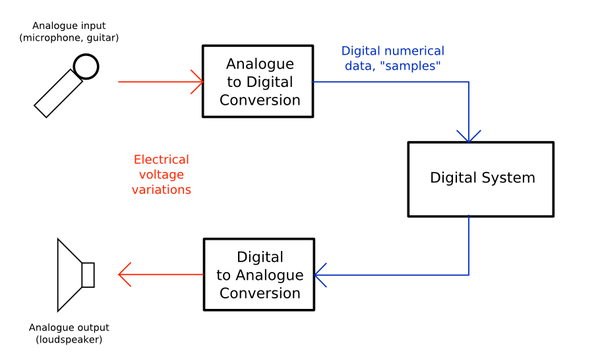Difference between revisions of "Sound"
(→Synthesising Sound) |
(→Representing Sound) |
||
| Line 1: | Line 1: | ||
{{partially done}} | {{partially done}} | ||
| + | ==Converting analogue to digital sound== | ||
| + | |||
| + | The following image demonstrates how sound files are created when they are inputted through devices such as a microphone: | ||
| + | |||
| + | [[File:600px-Analogue_Digital_Conversion.png]] | ||
| + | |||
==Representing Sound== | ==Representing Sound== | ||
Revision as of 09:38, 4 January 2017
![]() Needs Quiz
Needs Quiz
Contents
Converting analogue to digital sound
The following image demonstrates how sound files are created when they are inputted through devices such as a microphone:
Representing Sound
To store sound a digitizer is needed to convert the analogue sound into digital sound. An analogue to digital converter carries out these conversions. 16 bit ADC is enough for CD quality sound.
Sampling Rate
The sampling rate or frequency is the number of samples taken per second. It is measured in hertz (Hz)?. The higher the sampling rate the more accurate the representation of the sound.
Sampling Resolution
The sampling rate is the number of bits assigned to each sample. The more bits assigned the more accurate the representation of the sound.
Nyquist's Theorem
In 1928 Harry Nyquist found that in order to sample any sound you must use a sampling rate at double the frequency of the original sound. The result will be the closest possible to the original sound.
Audio Compression
Audio compression removes sounds and frequencies which we can't hear.
Synthesising Sound
Sound can be synthesised with MIDI (Musical Instrument Digital Interface), which records information about each note - such as duration, pitch, tempo, instrument and volume - and recreates that note when played. When using MIDI it is hard to replecate the proper soud as it would have to be played through note by note and would be a synthetic sound, in some cases it's good like in pop music but in other cases usually not. A MIDI link can hold up to 16 channels of information which can be routed to a seperate device for each channel.
